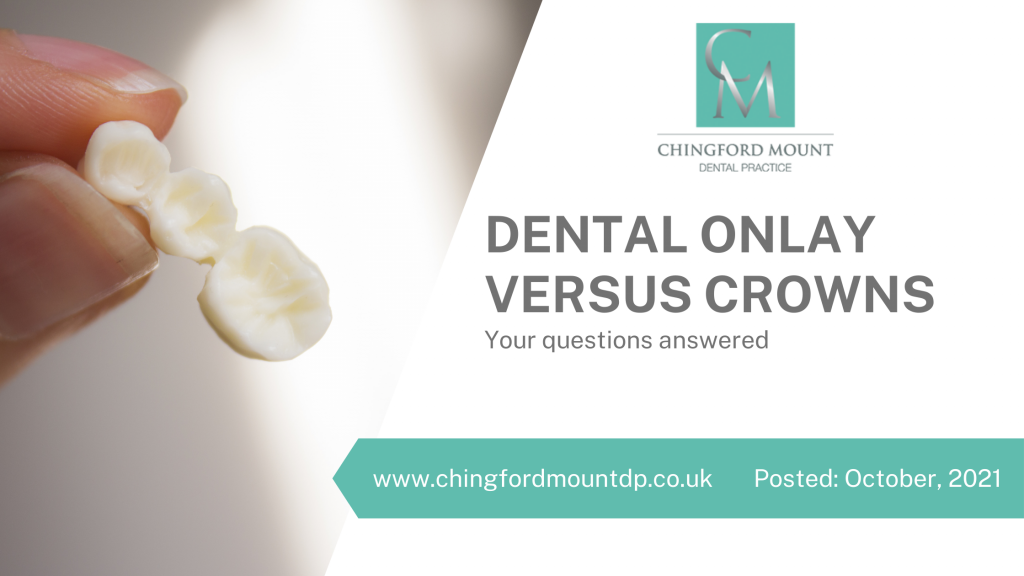
Most of us have heard about dental veneers and crowns as alternatives to direct tooth fillings. But many of us might not be aware of other dental restorations like dental inlays and onlays - which are equally beneficial in restoring grossly damaged teeth. This article explains everything you need to know about dental inlays and onlays and how they can help you achieve a lasting, healthy, and beautiful smile.
Dentistry: What Is an Onlay?
According to the American College of Prosthodontists, an onlay is an indirect restoration to replace a small amount of tooth structure lost due to tooth decay or trauma. Dental onlays are similar in design and structure to dental crowns. However, unlike crowns which rest on the entire visible portion of the tooth, onlay covers the tooth surface partially - only extending up to the chewing surfaces of the back teeth or the cusps of the tooth.
Should I Get An Inlay/Onlay Or A Traditional Composite Filling?
Dental inlays and onlays are prepared in the dental laboratory under controlled conditions. This means that restorations have fewer structural defects, and therefore, they tend to have superior aesthetics, strength, and durability compared with composite fillings. Hence, if you are looking for durable and aesthetically-pleasing restorations, you should consider getting inlays or inlays instead of direct composite fillings.
Can A Composite Be Used Instead Of A Crown For Teeth?
Composite fillings are suitable for restoring mild to moderately sized teeth cavities. However, in the case of larger areas of tooth decay or cases where higher strength is required, porcelain dental crowns are a more suitable option - as they possess superior strength, durability, and aesthetics.
Besides Filling, What Options Do I Have With A Cracked Tooth?
When a tooth gets cracked, your dentist will examine it thoroughly and look at its x-ray image to assess the extent of the damage. Typically, fractured teeth may be restored if the fracture line does not extend beyond the gum line. Your dentist will first replace the lost tooth structure with a suitable filling - silver amalgam or composites to restore a fractured tooth. Alternatively, your dentist may repair the damaged tooth using indirect restorations like crowns and onlays.
How Many Times Can You Get A Dental Filling (On The Same Tooth)?
Every time your dentist restores a tooth with dental fillings, they will remove the decayed tooth structure. Therefore, each filing process leaves lesser natural tooth structure behind to support the filling. Furthermore, the larger a filling is, the lesser number of times it can be replaced.
Why Are Dental Crowns Recommended After A Root Canal?
After a root canal treatment procedure, teeth tend to become weak and brittle. This is because root canal treatment devoids a tooth of its blood and nerve supply. That is why dentists recommend placing a crown over a root canal-treated tooth to reinforce it and prevent spontaneous fracture while eating.
What Are The Pros And Cons Of Dental Crowns?
The beneficial features of dental crowns include their superior strength, durability, and aesthetics. They are also a better option compared to composite filings when restoring teeth with extensive cavities. On the other hand, one of the major drawbacks of dental crowns is that natural and healthy tooth structure has to be sacrificed for their attachment to the underlying tooth. Besides, dental crowns are more expensive than direct filings.
What Are Alternatives To Dental Crowns?
There are several alternatives available to dental crowns:
- Composite Fillings - A commonly used dental crown alternative.
- Inlays
- Onlays
- Veneers
The choice of restoration depends on the extent of tooth damage, aesthetic needs, and budgetary constraints.
Why Do Dental Crowns Feel So Weird And Artificial?
Dental crowns are made from different materials than natural teeth. Besides, despite your dentist’s best efforts to ensure that your crowns do not feel excessively protruded, they may feel like a “foreign object” in the mouth, at least during the initial few days. However, soon your mouth will get used to them, and they will become a part of the oral cavity.
Can They Put Crown On Top Of Amalgam Fillings?
A crown can be placed on top of a natural tooth structure or any type of dental filling, whether composite or silver filings. The purpose of dental crowns is to restore teeth and improve their aesthetics. So, you can get dental crowns over silver amalgam filings.
How Long Does It Take To Place A Crown On A Tooth?
Dental crown placement is a straightforward process that is usually completed in 2-3 sittings. Conventionally, it may take up to 2 or three weeks from your first checkup appointment to getting your teeth restored with crowns. In some cases, it may be possible to get single-day crowns using CAD-CAM technology. Your dentist may give you an estimated timeline based on the type of crown used and the laboratory’s schedule - where the crown will be fabricated.
If you want your teeth restored with inlays, onlays, or crowns in Chingford, your first choice should be Chingford Mount Dental Practice. We have state-of-the-art dental equipment and a team of highly qualified and experienced to take care of your entire family’s dental care needs. So, what are you waiting for? Book a consultation appointment today, and let us give you a set of perfectly aligned teeth and a healthy, charming smile. We look forwards to serving you.











